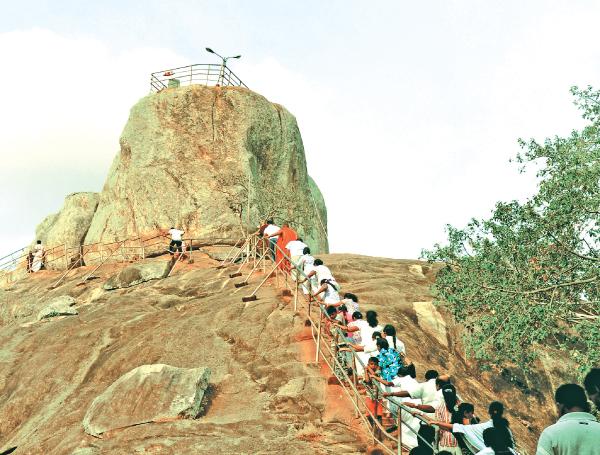
Buddhism to Sri Lanka becomes even more important.
Today Sri Lanka is renowned as the cradle of Theravada Buddhism because of the noble intentions of a great king from Jambudveepa or India. Emperor Asoka who was a mighty king in India had embraced Buddhism. He was on a great mission to propagate Buddhism throughout the Indian subcontinent and even the world. He was a close friend of King Devanampiyatissa (252-212 BC) who was the reigning monarch of ancient Sri Lanka. King Asoka dispatched a Buddhist delegation which included his son Arahat Mahinda Thera to Sri Lanka to propagate the Dhamma.
Mahinda Thera was accompanied by several other distinguished bhikkhus, namely Iththiya, Uththiya, Sambala, Baddasala, Sumana Samanera and an upasaka named Bhanuka .
The delegation visited the island in the month of Jetta (June), on Poson Poya Day which was declared a holiday by the reigning monarch.
Everyone was revelling and King Devanampiyatissa too was engaged in his favourite sport, hunting. During the days of the monarchy, hunting of animals was a popular sport carried out purely for pleasure.
The story of the historic first meeting on the summit of Missaka Pavva , the now famous Mihintale rock is not one that is unfamiliar to most of us.When Poson comes around we enjoy refreshing our minds about this significant meeting which is a turning point in history; the establishment of a new culture in this land.
The king was chasing behind an elk when he heard someone address him in a manner no one in the land would have dared to - a shortened form of his name, Tissa.
The king was taken aback totally, not only by the curt form of address, but also by the fact that someone was trying to capture his attention in this lonely forest. He looked everywhere - and then he was astonished to see a dignified monk in robes atop the summit.
Curious to know who he was and how he managed to get to the summit, the king questioned about his identity. Arahat Mahinda introduced himself and the others in the following Pali stanza;
Sammanah mayam maharaja
Dhammarajassa saavakah
Thameva anukampaya
Jambudveeipa idaagatah
 Translated into English it reads; Sramanas (monks) are we O great king. Disciples of the King of Truth, the Buddha. Out of compassion for thee, hither have we come from India.
Translated into English it reads; Sramanas (monks) are we O great king. Disciples of the King of Truth, the Buddha. Out of compassion for thee, hither have we come from India.
Then the King inquired as to how they arrived atop the rock and the answer given was that they came neither by land nor sea.
King Devanampiyatissa who realised that they had come by air was delighted to meet them and promptly laid aside his hunting gear and went along with his retinue to meet them and listen to what the thera had to say.
It was at this point that the kings knowledge was tested by Arahat Mahinda with a set of simple yet very tricky questions. (See page 14). Once the King answered these questions to the satisfaction of Arahat Mahinda, he delivered the Chula Hatthipadopama Sutta (the simile of the elephant footprint) with the fundamental tenets of Buddhism.
The Sutta opens with the indirect warning not to rush into conclusion at the first sign of evidence as a large footprint is not necessarily that of a great elephant. The Sutta also explains the life of a samana and also how one could become a Buddhist embracing the teachings of the Enlightened One, the Buddha.
King Devanampiyatissa who was so impressed by what he heard promptly embraced Buddhism and said, “ from henceforth the Thisarana - Buddha, Dhamma and Sanga, will be my refuge”.
This was a formal acceptance of Buddhism as the state religion. King Devanampiyatissa constructed a vihara and about 68 caves at the Missaka Pavva or Mihintale, which is about 1000 feet above sea level. Buddhism enabled many people to overcome a multitude of misconceptions they had and also harmful rituals they observed prior to practicing any religion.
The new system of belief and lifestyle enabled the people to walk in the path of righteousness and soon our motherland became known as a Dhammadeepa.
Buddhism which was decreed as the state religion by King Devanampiyatissa in 253 BC still enjoys this status in the country.
Today Sri Lanka is recognised as the cradle of Theravada Buddhism as it is only in our country that Buddhism is still practised in its purest form, enriching the mind of all its followers. On this Poson Poya Day let the sublime truth that the Buddha preached enlighten you and enable you to walk in the path He showed, observing the Five Precepts of Buddhism.
- Internet
